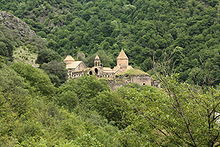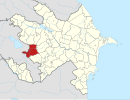This is an old revision of this page, as edited by Գարիկ Ավագյան (talk | contribs) at 13:18, 24 July 2021. The present address (URL) is a permanent link to this revision, which may differ significantly from the current revision.
Revision as of 13:18, 24 July 2021 by Գարիկ Ավագյան (talk | contribs)(diff) ← Previous revision | Latest revision (diff) | Newer revision → (diff) District of Azerbaijan District in Kalbajar-Lachin, Azerbaijan| Kalbajar District | |
|---|---|
| District | |
 Map of Azerbaijan showing Kalbajar (red) district. Part of the district (light red) is controlled by the self-proclaimed Republic of Artsakh, as part of the local Martakert Province Map of Azerbaijan showing Kalbajar (red) district. Part of the district (light red) is controlled by the self-proclaimed Republic of Artsakh, as part of the local Martakert Province | |
| Country | |
| Region | Kalbajar-Lachin |
| Established | 8 August 1930 |
| Capital | Kalbajar |
| Settlements | 147 |
| Area | |
| • Total | 3,050 km (1,180 sq mi) |
| Population | |
| • Total | 94,100 |
| • Density | 31/km (80/sq mi) |
| Time zone | UTC+4 (AZT) |
| Postal code | 3200 |
| Website | kelbecer-ih |
Kalbajar District (Template:Lang-az) is one of the 66 districts of Azerbaijan. It is located in the west of the country and belongs to the Eastern Zangezur Economic Region. The district borders the districts of Lachin, Khojaly, Agdam, Tartar, Goranboy, Goygol, Dashkasan, as well as the Gegharkunik and Vayots Dzor provinces of Armenia. Its capital and largest city is Kalbajar. As of 2020, the district had a nominal population of 94,100.
History

In Turkic Kalbajar means "Castle on the mouth of the river". The city of Kalbajar was renamed to Karvachar (Template:Lang-hy) after its control, which corresponds to the ancient district of Vaykunik, one of 12 cantons of Artsakh (historical Nagorno-Karabakh). It was also known as Upper-Khachen or Tsar (after its chief town) and was ruled by one of the branches of the House of Khachen, who held it until the Russian conquest of the Karabakh region in the early 19th century. In 1992 Azerbaijani government abolished Mardakert district of NKAO, and its western part was included in Kelbajar district.
Armenian occupation
As a result of the First Nagorno-Karabakh War, the area was occupied by Armenian forces on April 3, 1993. The district was declared a part of the self-proclaimed Republic of Artsakh, although it continued to be recognized by United Nations as a territory of the Republic of Azerbaijan. The Azeri population of Kalbajar were displaced and lived as internally displaced persons in other regions of Azerbaijan. The district was made into the Shahumyan Province, one of the eight regions of NKR. The region remained the least populated of the NKR regions with a total population of 2,800. The town of Kalbajar was home to 500 Armenian residents.
Return to Azerbaijan
Under the terms of the agreement that ended the 2020 Nagorno-Karabakh War, most of the district (i.e. Kelbajar district within its Soviet time borders) returned to Azerbaijani control. The eastern part of the district, which was part of Martakert Province, remained under the control of the Republic of Artsakh. Initially, the western part was to be returned to Azerbaijani control by 15 November 2020, but this deadline was subsequently extended to 25 November 2020. In the early hours of November 25, Azerbaijani forces entered the region; it was the second region to be returned to Azerbaijan per the ceasefire agreement.
Cultural monuments
The district has close to 750 Armenian cultural monuments, which include monasteries, churches, chapels, fortresses, khachkars and inscriptions. The most well-known is the monasteries of Dadivank and Gandzasar.
Demographics
As of 1979 the region excluding Nagorno Karabakh had a population of 40,516:
- Azerbaijanis 99.5% (40,329)
- Armenians 0.1% (49)
- Lezgins 0.1% (30)
- Russians 0.1% (46)
In 1980, the population was 40,300, counting 124 settlements. 8 of these settlements were Kurdish.
The population, excluding Nagorno Karabakh, grew to 43,713 by 1989.
As of 1989, the population in the Kalbajar District (including part of the now-abolished Mardakert district) was 66,211, however the census counts were not carried out in Armenian-controlled regions.
- Azerbaijanis 83.2% (55,082)
- Armenians 14.8% (9,794)
- Lezgins 0,1% (9)
- Kurds 1.9% (1,248)
- Russians 0.1% (23)
- Other 0.1%(45)
During Armenian control
Starting in the early 2000s, the district was slowly repopulated by Armenian settlers from eastern Shahumyan and Gulustan area.
According to 2005 Artsakh census, 2,560 Armenians were living in the western part of the Shahumyan Province, which roughly corresponded to the Soviet Kalbajar District. The number gew to 2,800 by 2006.
By 2015, the number of Armenians who had moved to the district had grown to 3,090.
However, the international observers provided different figures. An OSCE Fact-Finding Mission visited the occupied territories of Azerbaijan in 2005 to inspect settlement activity in the area and report its findings to the Co-Chairs of the OSCE Minsk Group. According to FFM figures, at that time the number of Armenian settlers in Kelbajar District was approximately 1,500. The OSCE Minsk Group Co-Chairs, who conducted a Field Assessment Mission to the occupied territories of Azerbaijan in October 2010 reported that there was no significant growth in the population since 2005.
See also
References
- "İnzibati-ərazi vahidləri" (PDF). preslib.az. Retrieved 28 February 2021.
- ^ "Population of Azerbaijan". stat.gov.az. State Statistics Committee. Retrieved 22 February 2021.
- "Azərbaycanın regionları" (in Azerbaijani). Archived from the original on 2009-11-14.
- "Azərbaycan Respublikasında iqtisadi rayonların yeni bölgüsü haqqında Azərbaycan Respublikası Prezidentinin Fərmanı".
- Институт научной информации (Академия наук СССР), Всесоюзный институт научной и технической информации. Реферативный журнал: География, Выпуски 5-6.. — Издательство Академии наук СССР, 1975. — С. 36.
- ^ Robert H. Hewsen, Armenia: A Historical Atlas. The University of Chicago Press, 2001, pp. 40, 101-102, 264-265.
- "Государственный комитет по статистике Азербайджанской Республики". Archived from the original on 2009-11-14.
- UN Resolution 884
- "Azerbaijanis celebrate Karabakh deal". aa.com.tr. Anadolu Agency. 10 November 2020.
- "Азербайджан дал Армении отсрочку на вывод войск из Кельбаджара". РБК (in Russian). Retrieved 2020-11-15.
- "Azerbaijani Forces Enter Second District Returned By Armenia Under Nagorno-Karabakh Truce". RadioFreeEurope/RadioLiberty. Retrieved 2020-11-25.
- ^ "население азербайджана". www.ethno-kavkaz.narod.ru. Retrieved 11 October 2020.
- Müller, D. (2000). "The Kurds of Soviet Azerbaijan, 1920-91" (PDF). Central Asian Survey. 1. 19: 41-77. Retrieved 17 April 2021.
- "Демоскоп Weekly - Приложение. Справочник статистических показателей". www.demoscope.ru (in Russian). Retrieved 11 October 2020.
- The Nagorno-Karabakh Conflict: A Legal Analysis. Heiko Krüger. Springer, 2010. ISBN 3642117872, 9783642117879. p. 102
- "THE RESULTS OF 2005 OF THE NAGORNO-KARABAGH REPUBLIC, Part 2, Chapter 1, Table 1.1 NKR De Facto and De Jure Population by Administrative Territorial Distribution and Sex" (PDF). p. 23. Retrieved 2020-02-01.
- "Statistical yearbook of NKR, Population" (PDF). Archived from the original (PDF) on October 2020. Retrieved 2009-03-27.
{{cite journal}}: Check date values in:|archive-date=(help); Cite journal requires|journal=(help) - "THE RESULTS OF 2015 POPULATION CENSUS OF THE NAGORNO-KARABAGH REPUBLIC, Chapter 2, Table 1.2 NKR de facto and de jure population (urban, rural) according to administrative-territorial division and residence status" (PDF). Retrieved 2020-02-01.
- "Report of the OSCE Fact-Finding Mission (FFM) to the Occupied Territories of Azerbaijan Surrounding Nagorno-Karabakh (NK)" (PDF). OSCE. 28 February 2005. Retrieved 23 April 2021.
- "Report of the OSCE Minsk Group Co-Chairs' Field Assessment Mission to the Occupied Territories of Azerbaijan Surrounding Nagorno-Karabakh". OSCE Minsk Group. 24 March 2011. Retrieved 23 April 2021.
40°06′24″N 46°02′18″E / 40.1067°N 46.0383°E / 40.1067; 46.0383
Categories: